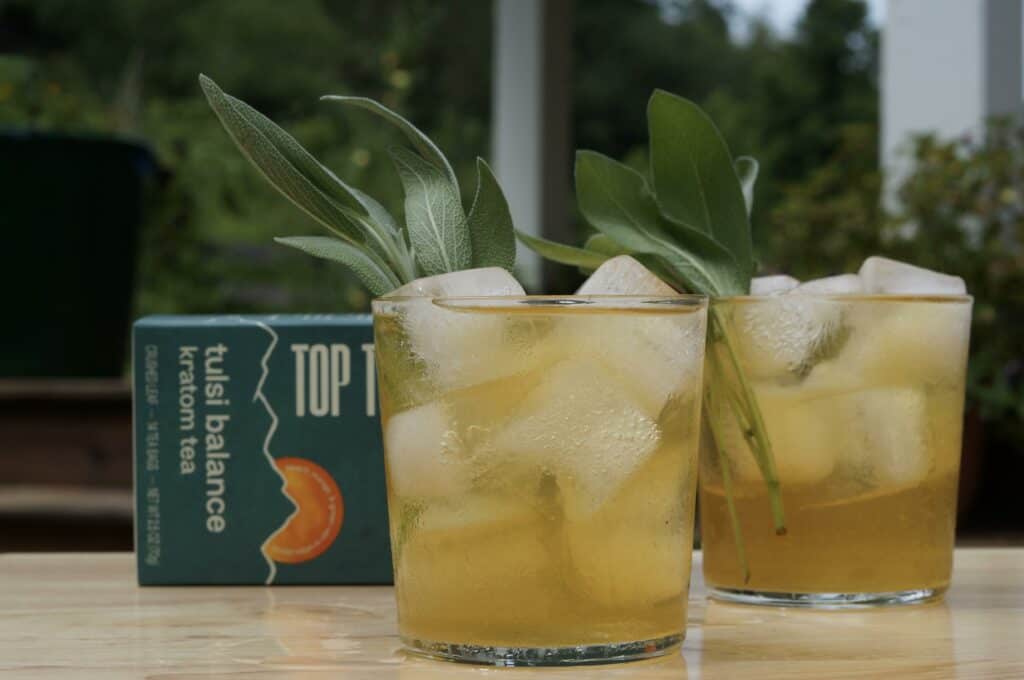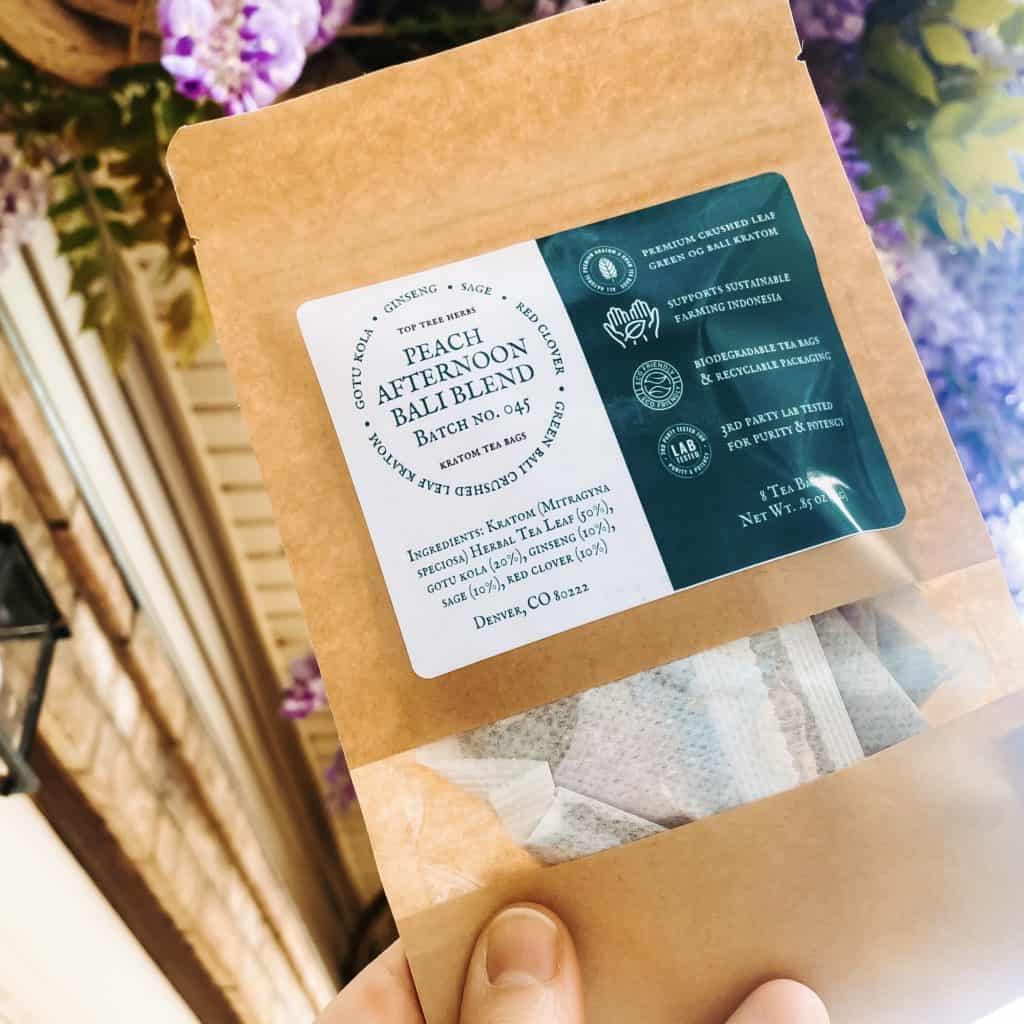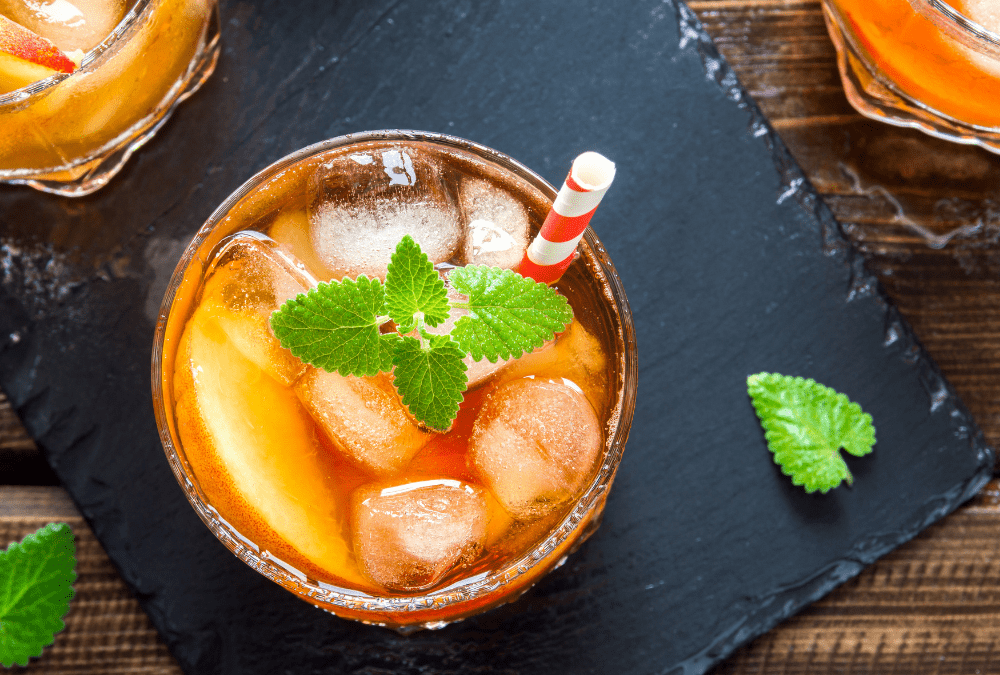Note: Where to Buy Kratom Herbal Tea?
We’re thrilled you’re interested in kratom herbal tea! We wanted to give you a quick heads up that this tea is no longer in stock, but we have an exciting selection of new kratom herbal blend tea bags that are fresh, effective, and delicious! And stay tuned for updates, we’ll do limited runs of our original kratom blends so they aren’t gone forever! See our current kratom tea bag menu here.
Meet Kratom Herbal Tea
Everything has a time and a place. So why would kratom tea be any different? When tea time rolls around, grab our latest afternoon tea blend! We’ve packed it full of delicious herbs, each with a long tradition of functional uses.
In this blog post we’re going to give you a brief rundown of the “why” behind each herb we chose to include in our afternoon tea blend. We’ve got kratom, gotu kola, ginseng, sage, and red clover. We then lightly spray the melody of herbs with a natural peach essential oil, rounding out the flavor to a pleasant reimaging of what kratom tea can be.

Green Bali Crushed Leaf Kratom (50%)
Kratom is a leaf from Mitragyna speciosa, an evergreen tree that grows throughout southeast Asia. The leaves have been picked and consumed in Thailand for at least 300 years.
Usually by farmers who chewed the leaves for energy and to withstand the heat. When not chewed, the leaves are also traditionally brewed into a tea which is sipped throughout the day.
The consumption pattern of kratom tea drinking is much like coffee in the US. In fact, kratom is a close relative of coffee, both being in the Rubiaceae family.Like coffee, kratom is great for energizing your day.
However, unlike coffee, kratom can also help you unwind and relax. To get this effect, simply drink more tea! This double property was our inspiration for kratom to be the driving force of our afternoon blend tea.
Gotu Kola (20%)
Centella asiatica, also known as Gotu Kola, is a flowering, perennial plant which grows in the wetlands of Asia. It serves as both a culinary and medicinal herb in the local traditions. The Lahu of northern Thailand believe that if you eat C. asiatica for every meal, daily for 3 years, you will become invulnerable to harm. (Voogelbreinder, 125)
In Burmese cuisine it is common to find gotu kola prepared as a mixed salad. In a way, it’s their version of lettuce. Many different dishes employ gotu kola in some sense for its renowned flavor. It is also pureed or boiled to make a sweet herbal beverage.
Looking broadly through the literature we can find hints at the medicinal properties that are baked into the long traditions of Southeast Asia. (Babu et al. 1995; Bremness 1994; Huang 1993; Kirtikar & Basu 1980; Miller 1985; Nadkarni 1976; Reid 1995) . In no particular order, there are hints that it can balance brain function across the hemispheres while improving learning and memory.
Indeed, it also has demonstrated the potential to accelerate cellular repair, e.g. skin and connective tissue, through improved peripheral circulation. Furthermore, it can stimulate the immune system and digestion. Finally, it also shows anti-inflammatory, wellness, and diuretic properties. (Voogelbreinder, 126)

Ginseng (10%)
Panax ginseng is a valuable, dense root which often takes an anthropomorphic appearance. In Traditional Chinese Medicine (TCM), ginseng is considered the “king of herbs”. Ginseng is recommended for many ailments as well as overall health.
In TCM it is believed to help the five sensory organs, and promote longevity. Carl Linnaeus, the famous botanist, named the genus. He chose the root word for panacea out of respect for its many uses. Thereby coining “panax.”
Despite it’s long heritage as a renowned beneficial herb, it has taken Western medicine many centuries to catch up with the traditional employment of ginseng.
In the light of more systematic scientific research, ginseng is now recognized as a useful adaptogen. (Brekhman & Dardymov 1969b; Fulder 1993; Gillis 1997; Hu 1976; Huang 1993; Kimmens ed. 1975) (Voogelbreinder, 256) Whereas it lacks alkaloids, the present understanding is that the compounds present in ginseng work synergistically.
What’s more, some folk medicine account report that ginseng can help with opium addiction. Occasionally with other herbs, such as those in the Papaver genus, but also alone.
The most compelling evidence of this came from work with rats in 2000 (Choi et al. 2000). Specifically, the ginsenosides of ginseng have a weak analgesic effects and can prevent morphine tolerance in rats.
Sage (10%)
Salvia officinalis, or common sage, is a common and popular culinary herb. It has a slight peppery flavor which stays on the tip of the tongue with a peppermint-like warmth, opening up the sinuses. It is a popular additive to black tea in Levant and Egypt.
In Crete and throughout Greece, 15-20 cm of fresh sage cut and brewed into a tea. Some say it promotes “a feeling of well-being” (Voogelbreinder, 297).
As is the case of many culinary herbs, there are reports of its use in traditional medicine as well as inebriating rituals. In fact, it derives its botanical name from the latin word for the herbal storeroom found in monasteries. The Romans treated it with ritual and great respect – the harvester having to wear a white tonic and bare feet. (Voogelbreinder, 297)
TCM suggests using it to relax the nervous system. Similarly, the Cherokee would use it along with its close cousin Salvia lyrata to deal with nervous debility (Voogelbreinder, 297). Studies have shown that S. officinalis yields between .7-2% essential oil. These include thujone, camphor, eucalyptol, linalool, and limonene, among others. It also has been found to contain up to 1.3% picrosalvins, a bitter diterpene diphenol lactone.
In our Afternoon Blend, sage brightens your cup with a warming calmness. Its classic flavor brings timelessness to the modern palate.
What is Red Clover tea? (10%)
Red Clover (Trifolium pratense) grows naturally throughout Eurasia and northern Africa. In it’s natural (and even introduced) ecology it is valued for its nitrogen fixation as well as pollinator attracting properties. It is considered the tastiest of the clovers, and also has a long history of use in Traditional Chinese Medicine.
Although the leaves are also edible, the purplish-pink flowers are preferred. The flowers are a sweet, mineral and vitamin rich addition popular in dishes and teas. In fact, the flower is not only edible when freshly picked, but is a favorite snack among children left to play in fields where it grows wild.
T. pratense is a wonderful source of isoflavones, which are phytoestrogens. The jury is still out on what all biological effects stem from consumption of these in large quantities (far greater quantities than are contained in the tea). At the moment research is pointing towards hormonal leveling effects, particularly in post-menopausal women.
Meet Kratom Herbal Tea
When it comes to an afternoon tea, you can’t beat our Peach Afternoon Blend. It is jam packed with traditional herbal spices and purported panaceas. We recommend that you use one of the blends with either a raw or flavored 3 gram kratom tea bag to harmonize flavor with punch.
Of course, always use some lemon to potentiate the kratom alkaloids and brew for at least 20 minutes. Check out our other articles on the art of brewing kratom tea if you want more tips and tricks to become an expert.
To better brews and one delicious afternoon tea.
Note: Voogelbreinder, Snu. Garden of Eden. 2009. Black Rainbow.





